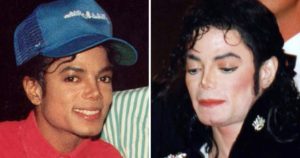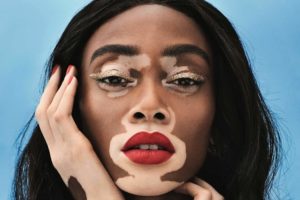unreasonable expectations
In today’s society, women face unreasonable expectations to prioritize their physical appearance rather than their mental health and personality. No matter their age, girls often cover their blemishes and “imperfections” with makeup in order to fit in and gain a sort of societal acceptance. Granted, this “cosmetic camouflage,” as some have come to brand it, can raise one’s confidence and self-esteem, making them more comfortable in their body.
While the rest of my friends happily patted on their foundation and glued on all sorts of eyelashes to get ready for parties and big events, I always remained hesitant to hop onto this bandwagon. I thought that if I put on makeup, then I would have to cover my vitiligo – thus conveying that my skin disease was bad and that I was covering it up because it was something I wasn’t proud of – which isn’t true.
After entering high school, I got some makeup for Christmas and my temptation grew. I started playing around with different foundations and concealers to cover my white skin to see what I would look like without vitiligo. I was really interested to see the transformation, as I never really considered how different I would look – or if I would look different at all. I covered the white on my eyelids with a dark brown eye shadow, used a concealer over my forehead and chin, and some lip gloss to darken my lips. Surprisingly, I saw someone in the mirror who I recognized. Honestly, she didn’t look all that different to the visible eye. But there was this little sting in my stomach, and it didn’t feel right. This wasn’t me.
I’m not someone who covers her vitiligo, and I don’t want to hide it. My white skin has become a part of me, and frankly, I can’t imagine myself without it. On the other hand, countless other individuals choose to cover their vitiligo daily – and I completely understand why. Vitiligo is a disease of the skin, but its harshest barriers are presented mentally; it feels like all your insecurities and vulnerabilities are on display for everyone to see, and it’s all they see. I want to acknowledge a few individuals for their vitiligo cases and how they used makeup in different ways to demonstrate the sheer power – both good and bad – of vitiligo.

A rather infamous case of this disease is Michael Jackson. Jackson’s vitiligo appeared and grew throughout his career, and a few professionals have claimed that it may have originated on his hands. In addition to being a talented performer, he was also talented at concealing his white skin, despite being immensely stressed and frustrated with the depigmentation. Eventually, instead of using dark makeup to cover his white skin, Jackson began wearing all white makeup. Some doctors have claimed that he used Benoquin, an FDA-approved “treatment” for vitiligo. However, this cream drains the rest of the pigmentation from his skin, rather than restoring it, thus explaining his transformation to all white skin. Michael Jackson’s story with vitiligo, while not a typical one, is a very extreme case of the psychological influence of this disease and the temptation to conceal the “flaws”. Being such a prominent star, it makes sense that Jackson was so stressed and determined to cover his vitiligo – because he didn’t know how his audience and his fans were going to react. He was probably scared, and some even suggest that vitiligo was an agent that led him to drug use.
While Michael Jackson’s experience with vitiligo is rather disheartening, I’m glad to say that there has been more public advocacy concerning skin-disease recently. Fortunately, there are models with vitiligo who have published their own personal stories and battles, such as Winnie Harlow. My family first spotted Harlow, a model with vitiligo, on a Desigual advertisement in Europe; ever since, I’ve been following her on Instagram and observing what she has done for the vitiligo community. Harlow has has vitilgo since she was 4. She competed on America’s Next Top Model and became a prominent advocate for skin disorders on popular media. Winnie poses proudly with her white skin, and has shown that vitiligo doesn’t have to hold anyone back from achieving their dreams. She acknowledges the challenge and the difficulty of overcoming the mental and societal barriers, but doesn’t say it’s impossible. I admire Winnie because she’s expanded her platform and reached diverse demographics of women, successfully sharing her story and encouraging others to do so. She’s also become close with Kim Kardashian over shared struggles with autoimmune conditions and together, these two women have been working on a KKW x Winnie makeup collection. While Winnie embraces the creativity and freedom of makeup, she also embraces her vitiligo and never really covers it up. I also really admire Logina Salah, a makeup artist with vitiligo. She has a rather flexible opinion, as she supports both covering and uncovering white skin. She believes everyone should feel comfortable with their skin and hide these “imperfections” and feel beautiful, but we shouldn’t let them get in and “destroy your inner peace.” Wearing makeup is an option; and no one should ever feel like they HAVE to wear makeup to be included and match our societal norms. I agree with Salah because ultimately, our goal is to feel comfortable and confident in our skin, and however we get there is valid. We all have different modes of coping, but the end goal is the same. You can wear as much or as little makeup as you want, and whether someone covers or displays their white patches, it makes no difference. Let’s share our beauty and encourage each other, because skin diseases should never rule our lives; instead, we’ll rule them.
there has been more public advocacy concerning skin-disease recently. Fortunately, there are models with vitiligo who have published their own personal stories and battles, such as Winnie Harlow. My family first spotted Harlow, a model with vitiligo, on a Desigual advertisement in Europe; ever since, I’ve been following her on Instagram and observing what she has done for the vitiligo community. Harlow has has vitilgo since she was 4. She competed on America’s Next Top Model and became a prominent advocate for skin disorders on popular media. Winnie poses proudly with her white skin, and has shown that vitiligo doesn’t have to hold anyone back from achieving their dreams. She acknowledges the challenge and the difficulty of overcoming the mental and societal barriers, but doesn’t say it’s impossible. I admire Winnie because she’s expanded her platform and reached diverse demographics of women, successfully sharing her story and encouraging others to do so. She’s also become close with Kim Kardashian over shared struggles with autoimmune conditions and together, these two women have been working on a KKW x Winnie makeup collection. While Winnie embraces the creativity and freedom of makeup, she also embraces her vitiligo and never really covers it up. I also really admire Logina Salah, a makeup artist with vitiligo. She has a rather flexible opinion, as she supports both covering and uncovering white skin. She believes everyone should feel comfortable with their skin and hide these “imperfections” and feel beautiful, but we shouldn’t let them get in and “destroy your inner peace.” Wearing makeup is an option; and no one should ever feel like they HAVE to wear makeup to be included and match our societal norms. I agree with Salah because ultimately, our goal is to feel comfortable and confident in our skin, and however we get there is valid. We all have different modes of coping, but the end goal is the same. You can wear as much or as little makeup as you want, and whether someone covers or displays their white patches, it makes no difference. Let’s share our beauty and encourage each other, because skin diseases should never rule our lives; instead, we’ll rule them.